The Effect of Co-Crystallising Sulphides and Precipitation Mechanisms on Sphalerite Geochemistry: A Case Study from the Hilton Zn-Pb (Ag) Deposit, Australia
Abstract
1. Introduction
2. Background
2.1. Regional Geology
2.2. Hilton Zn-Pb (Ag) Deposit Geology
3. Methods
3.1. Sampling Selection
3.2. LA-ICP-MS Anslyses
3.2.1. Spot Analyses
3.2.2. Trace Element Maps
3.2.3. Data Processing
4. Sphalerite Textures and Generations
4.1. Stratabound Sphalerite (Sph-1)
4.2. Disseminated Sphalerite Alteration (Sph-2)
4.3. Sphalerite in Early Ferroan-Dolomite Veins (Sph-3)
4.4. Sphalerite Dominated Breccias (Sph-4)
4.5. Sphalerite in Chalcopyrite Dominated Breccias (Sph-5)
4.6. Sphalerite in Late Ferroan-Dolomite Veins (Sph-6)
5. Results
5.1. LA-ICP-MS Spot Analysis
5.2. LA-ICP-MS Trace Element Maps
6. Discussion
6.1. Trace Element Substitution Mechanisms
6.2. Effects of Growth Conditions and Chemical Remobilisation on Sphalerite Geochemistry
6.2.1. Effect of Co-Crystallising Pyrite, Pyrrhotite and Galena
6.2.2. Effect of Recrystallisation with Abundant Neighbouring Co-Crystallising Sulphides
6.2.3. Effect of Chemical Remobilisation
7. Conclusions
- Sphalerite that has precipitated or recrystallised with neighbouring co-crystallising pyrite, pyrrhotite, galena and chalcopyrite is relatively depleted in the elements Fe, Co, In, Sn, Sb, Ag and Tl. This effect is due to the incorporation of these elements into the co-crystallising sulphide minerals.
- Sphalerite that is interpreted to have formed via chemical remobilisation is enriched in Zn, Ga, Ge and Sn, and depleted in Fe, Tl, Co, Bi, Ag, Sb and Mn relative to its parent material. The enrichment and depletion in trace elements from chemically remobilised sphalerite reflect their relative mobility, which allows them to be leached from the primary sphalerite into the secondary sphalerite. The relative depletion of Bi, Tl, Ag, and Sb in chemically remobilised sphalerite is associated with abundant co-crystallising galena, while the depletion in Fe and Mn may be attributed to co-crystallising ferroan-dolomite.
Supplementary Materials
Author Contributions
Funding
Acknowledgments
Conflicts of Interest
References
- Zhang, S.; Ding, Y.; Liu, B.; Chang, C. Supply and demand of some critical metals and present status of their recycling in WEEE. Waste Manag. 2017, 65, 113–127. [Google Scholar] [CrossRef] [PubMed]
- Watari, T.; Nansai, K.; Nakajima, K. Review of critical metal dynamics to 2050 for 48 elements. Resour. Conserv. Recycl. 2020, 155, 104669. [Google Scholar] [CrossRef]
- Cook, N.J.; Ciobanu, C.L. Mineral hosts for critical metals in hydrothermal ores. In Proceedings of the Mineral Resources in a Sustainable World, 13th SGA Biennial Meeting, Nancy, France, 24–27 August 2015; pp. 24–27. [Google Scholar]
- Sinclair, W.D. Electronic metals (In, Ge and Ga): Present and future resources. Acta Geol. Sin. Ed. 2014, 88, 463–465. [Google Scholar] [CrossRef]
- George, L.L.; Cook, N.J.; Ciobanu, C.L. Partitioning of trace elements in co-crystallized sphalerite–galena–chalcopyrite hydrothermal ores. Ore Geol. Rev. 2016, 77, 97–116. [Google Scholar] [CrossRef]
- Bauer, M.E.; Seifert, T.; Burisch, M.; Krause, J.; Richter, N.; Gutzmer, J. Indium-bearing sulfides from the Hämmerlein skarn deposit, Erzgebirge, Germany: Evidence for late-stage diffusion of indium into sphalerite. Miner. Depos. 2019, 54, 175–192. [Google Scholar] [CrossRef]
- Cook, N.J.; Ciobanu, C.L.; Pring, A.; Skinner, W.; Shimizu, M.; Danyushevsky, L.; Saini-Eidukat, B.; Melcher, F. Trace and minor elements in sphalerite: A LA-ICPMS study. Geochim. Cosmochim. Acta 2009, 73, 4761–4791. [Google Scholar] [CrossRef]
- Frenzel, M.; Hirsch, T.; Gutzmer, J. Gallium, germanium, indium, and other trace and minor elements in sphalerite as a function of deposit type—A meta-analysis. Ore Geol. Rev. 2016, 76, 52–78. [Google Scholar] [CrossRef]
- Ye, L.; Cook, N.J.; Ciobanu, C.L.; Yuping, L.; Qian, Z.; Tiegeng, L.; Wei, G.; Yulong, Y.; Danyushevskiy, L. Trace and minor elements in sphalerite from base metal deposits in South China: A LA-ICPMS study. Ore Geol. Rev. 2011, 39, 188–217. [Google Scholar] [CrossRef]
- Cugerone, A.; Cenki-Tok, B.; Oliot, E.; Muñoz, M.; Barou, F.; Motto-Ros, V.; Le Goff, E. Redistribution of germanium during dynamic recrystallization of sphalerite. Geology 2019, 48, 236–241. [Google Scholar] [CrossRef]
- Bauer, M.E.; Burisch, M.; Ostendorf, J.; Krause, J.; Frenzel, M.; Seifert, T.; Gutzmer, J. Trace element geochemistry of sphalerite in contrasting hydrothermal fluid systems of the Freiberg district, Germany: Insights from LA-ICP-MS analysis, near-infrared light microthermometry of sphalerite-hosted fluid inclusions, and sulfur isotope geochemi. Miner. Depos. 2019, 54, 237–262. [Google Scholar] [CrossRef]
- Henjes-Kunst, E.; Raith, J.G.; Boyce, A.J. Micro-scale sulfur isotope and chemical variations in sphalerite from the Bleiberg Pb-Zn deposit, Eastern Alps, Austria. Ore Geol. Rev. 2017, 90, 52–62. [Google Scholar] [CrossRef]
- Wei, C.; Ye, L.; Hu, Y.; Danyushevskiy, L.; Li, Z.; Huang, Z. Distribution and occurrence of Ge and related trace elements in sphalerite from the Lehong carbonate-hosted Zn-Pb deposit, northeastern Yunnan, China: Insights from SEM and LA-ICP-MS studies. Ore Geol. Rev. 2019, 115, 103175. [Google Scholar] [CrossRef]
- Valenta, R. Deformation, fluid flow and mineralization in the Hilton area, Mt Isa, Australia. Ph.D. Thesis, Monash University, Melbourne, Australia, June 1988. [Google Scholar]
- Wilson, A. Metal Distribution in the Hilton Mine, Mount Isa and its Genetic Implications. Honours Thesis, Monash University, Melbourne, Australia, 1992. [Google Scholar]
- Valenta, R. Deformation of host rocks and stratiform mineralization in the Hilton Mine area, Mt Isa. Aust. J. Earth Sci. 1994, 41, 429–443. [Google Scholar] [CrossRef]
- Valenta, R. Syntectonic discordant copper mineralization in the Hilton Mine, Mount Isa. Econ. Geol. 1994, 89, 1031–1052. [Google Scholar] [CrossRef]
- Southgate, P.N. Carpentaria-Mt Isa Zinc Belt: Basement framework, chronostratigraphy and geodynamic evolution of Proterozoic successions. Aust. J. Earth Sci. 2000, 47, 337–340. [Google Scholar] [CrossRef]
- Page, R.W.; Jackson, M.J.; Krassay, A.A. Constraining sequence stratigraphy in north Australian basins: SHRIMP U–Pb zircon geochronology between Mt Isa and McArthur River. Aust. J. Earth Sci. 2000, 47, 431–459. [Google Scholar] [CrossRef]
- Southgate, P.N.; Neumann, N.L.; Gibson, G.M. Depositional systems in the Mt Isa Inlier from 1800 Ma to 1640 Ma: Implications for Zn–Pb–Ag mineralisation. Aust. J. Earth Sci. 2013, 60, 157–173. [Google Scholar] [CrossRef]
- Domagala, J.; Southgate, P.N.; McConachie, B.A.; Pidgeon, B.A. Evolution of the Palaeoproterozoic Prize, Gun and lower Loretta Supersequences of the Surprise Creek Formation and Mt Isa Group. Aust. J. Earth Sci. 2000, 47, 485–507. [Google Scholar] [CrossRef]
- Scott, D.L.; Rawlings, D.J.; Page, R.W.; Tarlowski, C.Z.; Idnurm, M.; Jackson, M.J.; Southgate, P.N. Basement framework and geodynamic evolution of the Palaeoproterozoic superbasins of north-central Australia: An integrated review of geochemical, geochronological and geophysical data. Aust. J. Earth Sci. 2000, 47, 341–380. [Google Scholar] [CrossRef]
- Betts, P.G.; Giles, D.; Mark, G.; Lister, G.S.; Goleby, B.R.; Aillères, L. Synthesis of the Proterozoic evolution of the Mt Isa Inlier. Aust. J. Earth Sci. 2006, 53, 187–211. [Google Scholar] [CrossRef]
- Neumann, N.L.; Southgate, P.N.; Gibson, G.M.; McIntyre, A. New SHRIMP geochronology for the Western Fold Belt of the Mt Isa Inlier: Developing a 1800–1650 Ma event framework. Aust. J. Earth Sci. 2006, 53, 1023–1039. [Google Scholar] [CrossRef]
- Page, R.W.; Bell, T.H. Isotopic and structural responses of granite to successive deformation and metamorphism. J. Geol. 1986, 94, 365–379. [Google Scholar] [CrossRef]
- Winsor, C.N. Intermittent folding and faulting in the Lake Moondarra area, Mount Isa, Queensland. Aust. J. Earth Sci. 1986, 33, 27–42. [Google Scholar] [CrossRef]
- Connors, K.A.; Page, R.W. Relationships between magmatism, metamorphism and deformation in the western Mount Isa Inlier, Australia. Precambrian Res. 1995, 71, 131–153. [Google Scholar] [CrossRef]
- Duncan, R.J.; Wilde, A.R.; Bassano, K.; Maas, R. Geochronological constraints on tourmaline formation in the Western Fold Belt of the Mount Isa Inlier, Australia: Evidence for large-scale metamorphism at 1.57 Ga? Precambrian Res. 2006, 146, 120–137. [Google Scholar] [CrossRef]
- Hand, M.; Rubatto, D. The scale of the thermal problem in the Mt Isa Inlier. In Geological Society of Australia Abstracts; Geological Society of Australia: Hornsby, Australia, 2002; Volume 67, p. 173. [Google Scholar]
- Chapman, L.H. Geology and Genesis of the George Fisher Zn-Pb-Ag deposit Mount Isa, Australia. Ph.D. Thesis, James Cook University, Townsville, Australia, 1999. [Google Scholar]
- Bell, T.H.; Hickey, K.A. Multiple deformations with successive subvertical and subhorizontal axial planes in the Mount Isa region; their impact on geometric development and significance for mineralization and exploration. Econ. Geol. 1998, 93, 1369–1389. [Google Scholar] [CrossRef]
- Perkins, W.G.; Bell, T.H. Stratiform replacement lead-zinc deposits; a comparison between Mount Isa, Hilton, and McArthur River. Econ. Geol. 1998, 93, 1190–1212. [Google Scholar] [CrossRef]
- Danyushevsky, L.; Robinson, P.; Gilbert, S.; Norman, M.; Large, R.; McGoldrick, P.; Shelley, M. Routine quantitative multi-element analysis of sulphide minerals by laser ablation ICP-MS: Standard development and consideration of matrix effects. Geochemistry Explor. Environ. Anal. 2011, 11, 51–60. [Google Scholar] [CrossRef]
- Norris, A.; Danyushevsky, L. Towards Estimating the Complete Uncertainty Budget of Quantified Results Measured by LA-ICPMS; Goldschmidt: Boston, MA, USA, 2018. [Google Scholar]
- Paton, C.; Hellstrom, J.; Paul, B.; Woodhead, J.; Hergt, J. Iolite: Freeware for the visualisation and processing of mass spectrometric data. J. Anal. At. Spectrom. 2011, 26, 2508–2518. [Google Scholar] [CrossRef]
- Woodhead, J.D.; Hellstrom, J.; Hergt, J.M.; Greig, A.; Maas, R. Isotopic and elemental imaging of geological materials by laser ablation inductively coupled plasma-mass spectrometry. Geostand. Geoanalytical Res. 2007, 31, 331–343. [Google Scholar] [CrossRef]
- Chapman, L.H. Geology and mineralization styles of the George Fisher Zn-Pb-Ag deposit, Mount Isa, Australia. Econ. Geol. 2004, 99, 233–255. [Google Scholar] [CrossRef]
- Rieger, P.; Magnall, J.M.; Gleeson, S.A.; Lilly, R.; Rocholl, A.; Kusebauch, C. Sulfur Isotope Constraints on the Conditions of Pyrite Formation in the Paleoproterozoic Urquhart Shale Formation and George Fisher Zn-Pb-Ag Deposit, Northern Australia. Econ. Geol. 2020. [Google Scholar] [CrossRef]
- Yuan, B.; Zhang, C.; Yu, H.; Yang, Y.; Zhao, Y.; Zhu, C.; Ding, Q.; Zhou, Y.; Yang, J.; Xu, Y. Element enrichment characteristics: Insights from element geochemistry of sphalerite in Daliangzi Pb–Zn deposit, Sichuan, Southwest China. J. Geochem. Explor. 2018, 186, 187–201. [Google Scholar] [CrossRef]
- Belissont, R.; Boiron, M.-C.; Luais, B.; Cathelineau, M. LA-ICP-MS analyses of minor and trace elements and bulk Ge isotopes in zoned Ge-rich sphalerites from the Noailhac–Saint-Salvy deposit (France): Insights into incorporation mechanisms and ore deposition processes. Geochim. Cosmochim. Acta 2014, 126, 518–540. [Google Scholar] [CrossRef]
- Cooke, D.R.; Bull, S.W.; Large, R.R.; McGoldrick, P.J. The importance of oxidized brines for the formation of Australian Proterozoic stratiform sediment-hosted Pb-Zn (Sedex) deposits. Econ. Geol. 2000, 95, 1–18. [Google Scholar] [CrossRef]
- Murphy, T.E. Structural and Stratigraphic Controls on Mineralization at the George Fisher Zn-Pb-Ag Deposit, Northwest Queensland, Australia. Ph.D. Thesis, James Cook University, Townsville, Australia, 2004. [Google Scholar]
- Lockington, J.A.; Cook, N.J.; Ciobanu, C.L. Trace and minor elements in sphalerite from metamorphosed sulphide deposits. Mineral. Petrol. 2014, 108, 873–890. [Google Scholar] [CrossRef]
- Campbell, F.A.; Ethier, V.G. Nickel and cobalt in pyrrhotite and pyrite from the Faro and Sullivan orebodies. Can. Mineral. 1984, 22, 503–506. [Google Scholar]
- Witt, W.K.; Hagemann, S.G.; Roberts, M.; Davies, A. Cobalt enrichment at the Juomasuo and Hangaslampi polymetallic deposits, Kuusamo Schist Belt, Finland: A role for an orogenic gold fluid? Miner. Depos. 2019, 55, 1–8. [Google Scholar] [CrossRef]
- Frenzel, M.; Bachmann, K.; Carvalho, J.R.S.; Relvas, J.M.R.S.; Pacheco, N.; Gutzmer, J. The geometallurgical assessment of by-products—Geochemical proxies for the complex mineralogical deportment of indium at Neves-Corvo, Portugal. Miner. Depos. 2018, 54, 1–24. [Google Scholar] [CrossRef]
- George, L.L.; Biagioni, C.; Lepore, G.O.; Lacalamita, M.; Agrosì, G.; Capitani, G.C.; Bonaccorsi, E.; d’Acapito, F. The speciation of thallium in (Tl, Sb, As)-rich pyrite. Ore Geol. Rev. 2019, 107, 364–380. [Google Scholar] [CrossRef]
- Grant, H.L.J.; Hannington, M.D.; Petersen, S.; Frische, M.; Fuchs, S.H. Constraints on the behavior of trace elements in the actively-forming TAG deposit, Mid-Atlantic Ridge, based on LA-ICP-MS analyses of pyrite. Chem. Geol. 2018, 498, 45–71. [Google Scholar] [CrossRef]
- George, L.; Cook, N.J.; Ciobanu, C.L.; Wade, B.P. Trace and minor elements in galena: A reconnaissance LA-ICP-MS study. Am. Mineral. 2015, 100, 548–569. [Google Scholar] [CrossRef]
- Cave, B.; Lilly, R.; Barovich, K. Textural and geochemical analysis of chalcopyrite, galena and sphalerite across the Mount Isa Cu to Pb-Zn transition: Implications for a zoned Cu-Pb-Zn system. Ore Geol. Rev. 2020, 124, 103647. [Google Scholar] [CrossRef]
- Höll, R.; Kling, M.; Schroll, E. Metallogenesis of germanium—A review. Ore Geol. Rev. 2007, 30, 145–180. [Google Scholar] [CrossRef]
- Burton, J.D.; Culkin, F.; Riley, J.P. The abundances of gallium and germanium in terrestrial materials. Geochim. Cosmochim. Acta 1959, 16, 151–180. [Google Scholar] [CrossRef]
- Bernstein, L.R. Germanium geochemistry and mineralogy. Geochim. Cosmochim. Acta 1985, 49, 2409–2422. [Google Scholar] [CrossRef]
- Jonsson, E.; Högdahl, K. On the occurrence of gallium and germanium in the Bergslagen ore province, Sweden. GFF 2019, 141, 48–53. [Google Scholar] [CrossRef]
- Goldsmith, J.R. Gallium and germanium substitutions in synthetic feldspars. J. Geol. 1950, 58, 518–536. [Google Scholar] [CrossRef]
- Schwartz, M.O. Cadmium in zinc deposits: Economic geology of a polluting element. Int. Geol. Rev. 2000, 42, 445–469. [Google Scholar] [CrossRef]
- Wen, H.; Zhu, C.; Zhang, Y.; Cloquet, C.; Fan, H.; Fu, S. Zn/Cd ratios and cadmium isotope evidence for the classification of lead-zinc deposits. Sci. Rep. 2016, 6, 1–8. [Google Scholar] [CrossRef]
- Cugerone, A.; Cenki-Tok, B.; Chauvet, A.; Le Goff, E.; Bailly, L.; Alard, O.; Allard, M. Relationships between the occurrence of accessory Ge-minerals and sphalerite in Variscan Pb-Zn deposits of the Bossost anticlinorium, French Pyrenean Axial Zone: Chemistry, microstructures and ore-deposit setting. Ore Geol. Rev. 2018, 95, 1–19. [Google Scholar] [CrossRef]
- Cugerone, A.; Cenki-Tok, B.; Muñoz, M.; Kouzmanov, K.; Oliot, E.; Motto-Ros, V.; Le Goff, E. Behavior of critical metals in metamorphosed Pb-Zn ore deposits: Example from the Pyrenean Axial Zone. Miner. Depos. 2020, 1–21. [Google Scholar] [CrossRef]
- Lee, J.H.; Yoo, B.C.; Yang, Y.-S.; Lee, T.H.; Seo, J.H. Sphalerite Geochemistry of the Zn-Pb Orebodies in the Taebaeksan Metallogenic Province, Korea. Ore Geol. Rev. 2019, 107, 1046–1067. [Google Scholar] [CrossRef]
- Wang, Y.; Han, X.; Petersen, S.; Frische, M.; Qiu, Z.; Cai, Y.; Zhou, P. Trace Metal Distribution in Sulfide Minerals from Ultramafic-Hosted Hydrothermal Systems: Examples from the Kairei Vent Field, Central Indian Ridge. Minerals 2018, 8, 526. [Google Scholar] [CrossRef]
- Stanton, M.R.; Gemery-Hill, P.A.; Shanks, W.C., III; Taylor, C.D. Rates of zinc and trace metal release from dissolving sphalerite at pH 2.0–4.0. Appl. Geochem. 2008, 23, 136–147. [Google Scholar] [CrossRef]
- Wagner, T.; Cook, N.J. Sphalerite remobilization during multistage hydrothermal mineralization events—Examples from siderite-Pb-Zn-Cu-Sb veins, Rheinisches Schiefergebirge, Germany. Mineral. Petrol. 1998, 63, 223–241. [Google Scholar] [CrossRef]

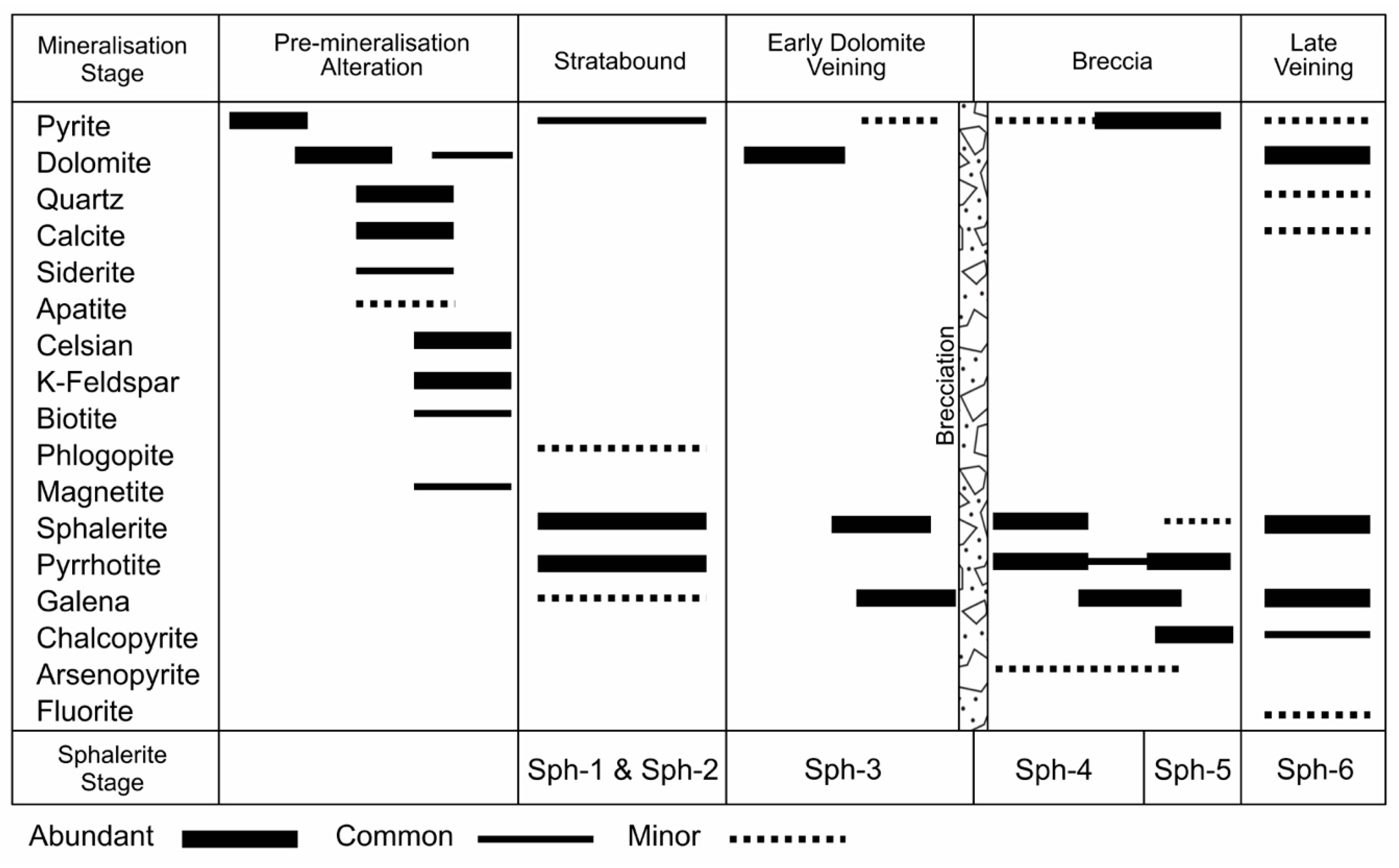

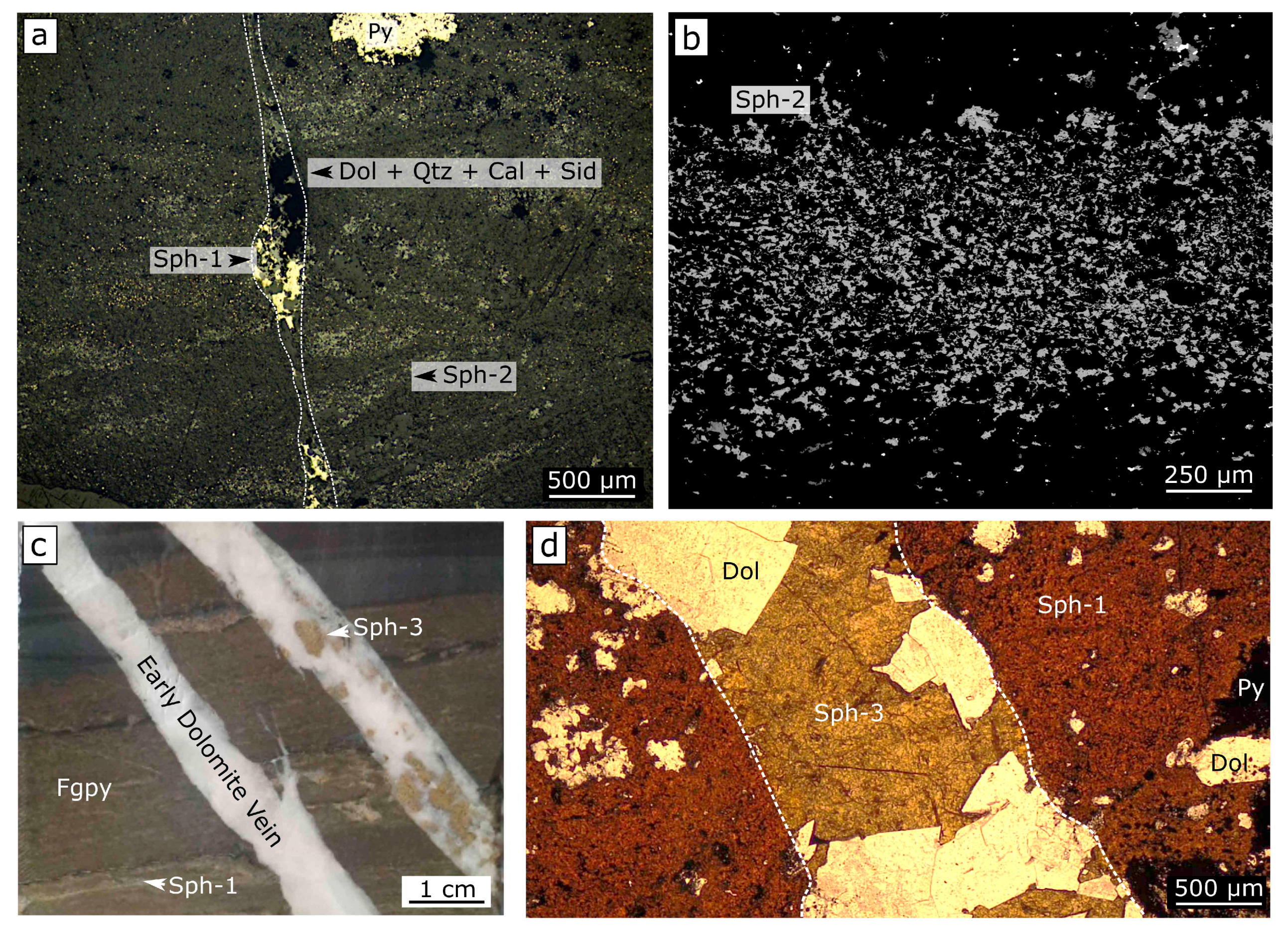

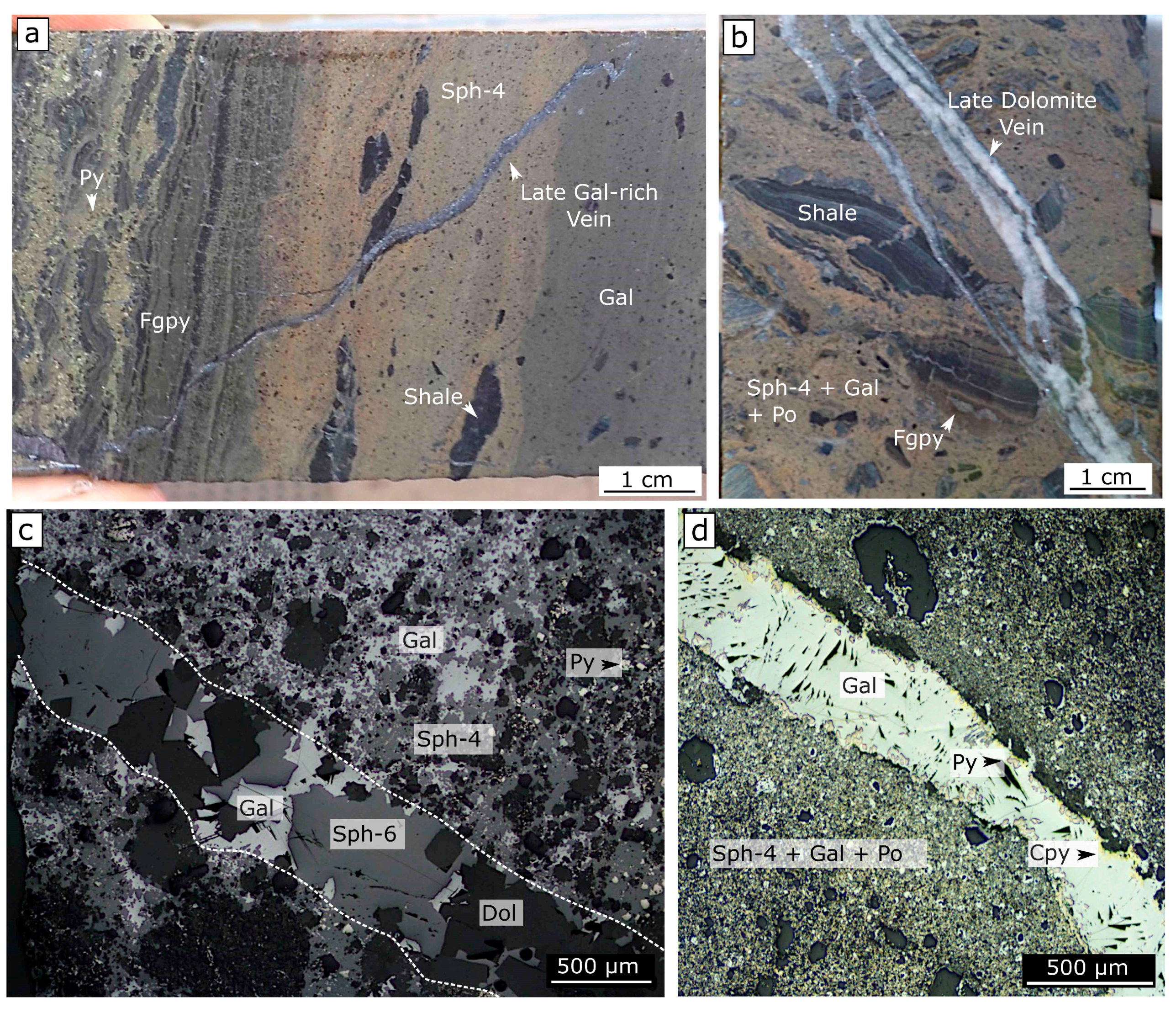

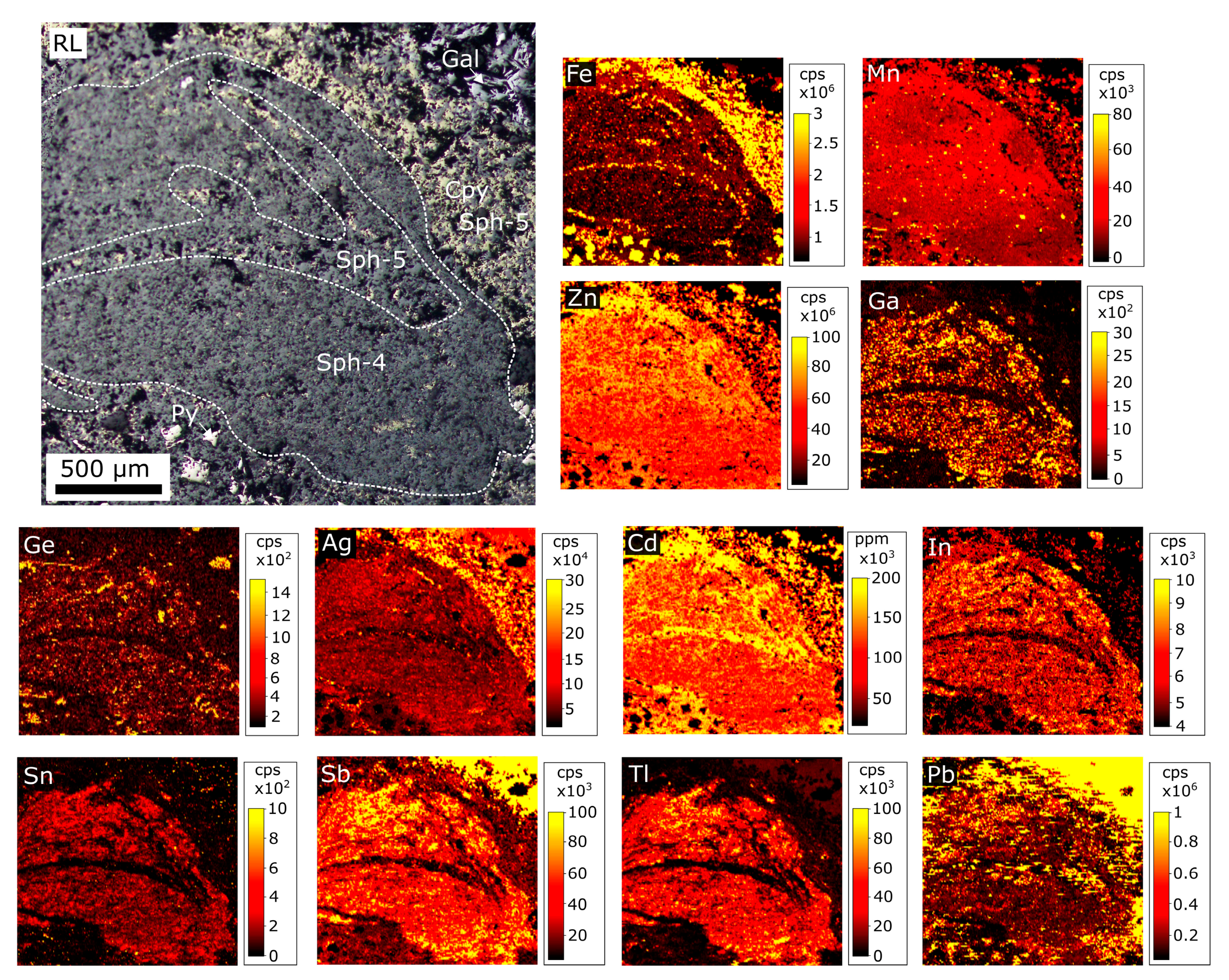
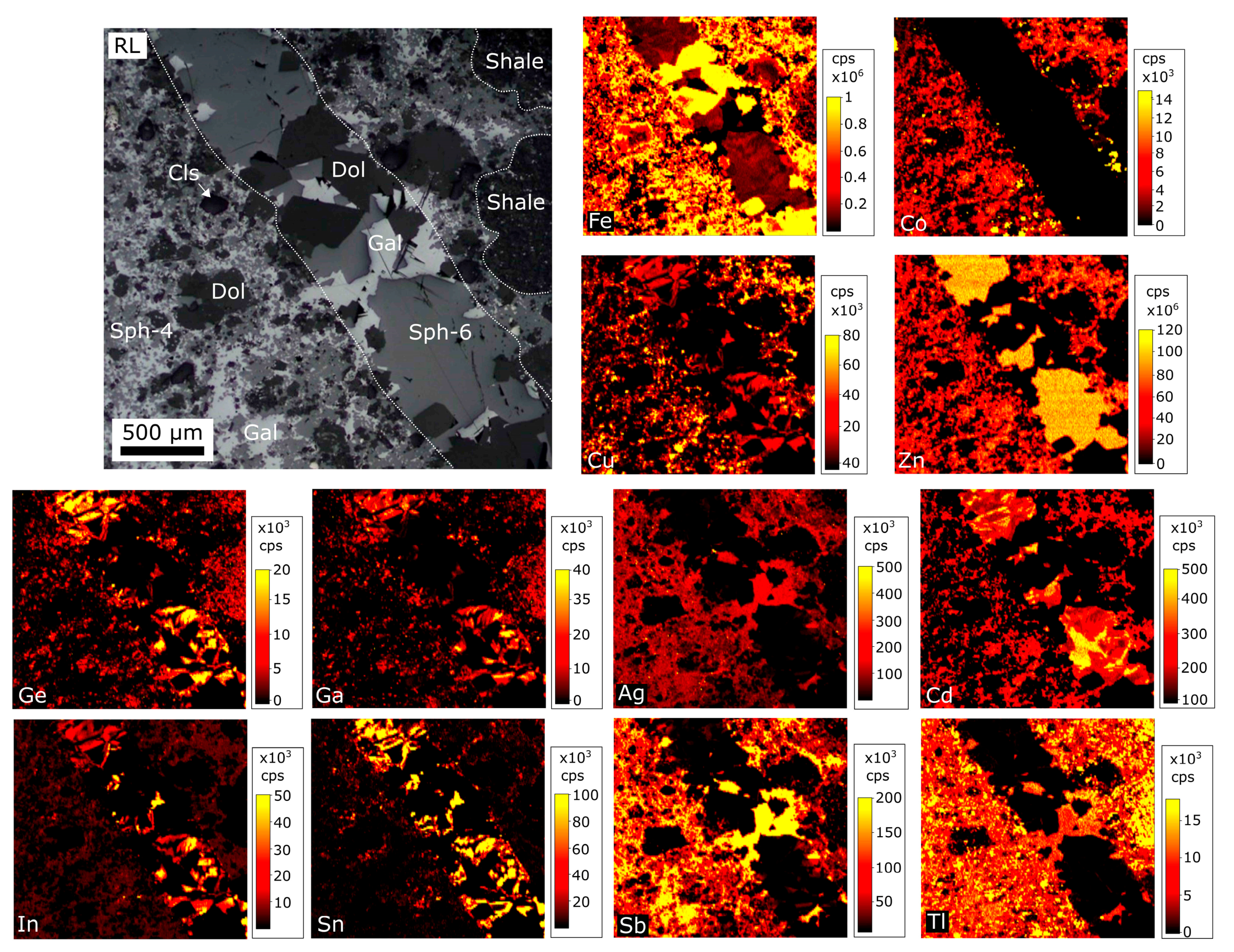

| Sphalerite | Descriptives | Zn (wt%) | Cd | Fe (wt%) | Ag | Sb | In | Sn |
|---|---|---|---|---|---|---|---|---|
| Sph-1 | Min | 56.88 | 768 | 0.71 | 13.28 | 0.61 | 0.02 | 0.00 |
| Median | 63.45 | 1515 | 2.73 | 104.79 | 16.60 | 2.97 | 0.44 | |
| StDev | 1.59 | 439 | 1.38 | 85.72 | 15.21 | 4.87 | 0.27 | |
| Max | 65.74 | 2968 | 5.09 | 361.09 | 61.96 | 15.53 | 1.75 | |
| Sph-2 | Min | 58.22 | 970 | 3.00 | 10.28 | 1.39 | 1.05 | 0.00 |
| Median | 62.20 | 1657 | 4.36 | 91.13 | 73.96 | 5.92 | 5.78 | |
| StDev | 1.14 | 387 | 1.12 | 68.27 | 96.71 | 7.02 | 4.84 | |
| Max | 63.49 | 2306 | 8.29 | 261.32 | 383.10 | 22.50 | 16.78 | |
| Sph-3 | Min | 59.76 | 1501 | 0.63 | 11.77 | 1.32 | 0.00 | 0.11 |
| Median | 65.00 | 2676 | 1.44 | 152.99 | 14.52 | 1.00 | 2.95 | |
| StDev | 0.93 | 412 | 0.30 | 116.95 | 10.95 | 0.85 | 2.91 | |
| Max | 66.18 | 4051 | 1.92 | 449.83 | 49.36 | 3.54 | 14.00 | |
| Sph-4 | Min | 54.49 | 1098 | 1.30 | 6.04 | 0.89 | 0.00 | 0.00 |
| Median | 62.16 | 2132 | 4.15 | 114.50 | 70.67 | 3.00 | 5.52 | |
| StDev | 1.54 | 430 | 1.41 | 92.82 | 86.35 | 1.49 | 15.76 | |
| Max | 65.43 | 3711 | 11.79 | 692.70 | 673.50 | 8.12 | 119.94 | |
| Sph-6 | Min | 59.66 | 955 | 0.77 | 0.90 | 0.23 | 0.04 | 0.18 |
| Median | 64.69 | 2025 | 2.02 | 40.67 | 21.08 | 14.21 | 36.55 | |
| StDev | 1.69 | 633 | 1.48 | 51.80 | 27.64 | 22.31 | 49.12 | |
| Max | 66.10 | 3666 | 6.17 | 283.47 | 140.94 | 103.88 | 272.93 | |
| Sphalerite | Descriptives | Tl | Cu | Ga | Ge | Mn | Co | Bi |
| Sph-1 | Min | 0.00 | 19.86 | 0.00 | 0.00 | 2 | 0.00 | 0.01 |
| Median | 2.20 | 502.51 | 0.95 | 3.28 | 40 | 1.49 | 0.02 | |
| StDev | 3.13 | 816.98 | 2.07 | 8.53 | 79 | 2.61 | 0.01 | |
| Max | 29.80 | 4077.06 | 18.32 | 46.26 | 611 | 17.81 | 0.06 | |
| Sph-2 | Min | 0.00 | 46.87 | 0.00 | 0.00 | 11 | 0.00 | 0.02 |
| Median | 13.25 | 378.55 | 5.04 | 14.40 | 105 | 16.22 | 0.10 | |
| StDev | 17.23 | 591.96 | 9.26 | 28.04 | 129 | 19.19 | 0.03 | |
| Max | 66.51 | 2984.88 | 39.53 | 124.77 | 613 | 53.31 | 0.16 | |
| Sph-3 | Min | 0.05 | 42.45 | 2.34 | 10.78 | 5 | 0.00 | 0.01 |
| Median | 1.39 | 191.10 | 9.80 | 72.38 | 30 | 0.10 | 0.01 | |
| StDev | 1.23 | 167.01 | 6.95 | 74.80 | 74 | 0.17 | 0.00 | |
| Max | 4.55 | 751.87 | 36.71 | 314.16 | 478 | 0.76 | 0.02 | |
| Sph-4 | Min | 0.00 | 16.92 | 0.00 | 0.00 | 3 | 0.00 | 0.01 |
| Median | 7.07 | 1017.44 | 4.18 | 5.62 | 80 | 21.14 | 0.03 | |
| StDev | 17.20 | 1824.00 | 11.98 | 16.03 | 218 | 23.28 | 0.02 | |
| Max | 146.81 | 17,137.82 | 75.14 | 94.39 | 1989 | 113.56 | 0.13 | |
| Sph-6 | Min | 0.00 | 2.77 | 0.12 | 0.30 | 2 | 0.00 | 0.01 |
| Median | 0.35 | 549.30 | 8.59 | 56.66 | 25 | 0.04 | 0.01 | |
| StDev | 0.73 | 1253.63 | 8.79 | 60.14 | 93 | 0.23 | 0.01 | |
| Max | 3.78 | 5621.73 | 47.21 | 229.28 | 810 | 2.04 | 0.08 |
© 2020 by the authors. Licensee MDPI, Basel, Switzerland. This article is an open access article distributed under the terms and conditions of the Creative Commons Attribution (CC BY) license (http://creativecommons.org/licenses/by/4.0/).
Share and Cite
Cave, B.; Lilly, R.; Hong, W. The Effect of Co-Crystallising Sulphides and Precipitation Mechanisms on Sphalerite Geochemistry: A Case Study from the Hilton Zn-Pb (Ag) Deposit, Australia. Minerals 2020, 10, 797. https://doi.org/10.3390/min10090797
Cave B, Lilly R, Hong W. The Effect of Co-Crystallising Sulphides and Precipitation Mechanisms on Sphalerite Geochemistry: A Case Study from the Hilton Zn-Pb (Ag) Deposit, Australia. Minerals. 2020; 10(9):797. https://doi.org/10.3390/min10090797
Chicago/Turabian StyleCave, Bradley, Richard Lilly, and Wei Hong. 2020. "The Effect of Co-Crystallising Sulphides and Precipitation Mechanisms on Sphalerite Geochemistry: A Case Study from the Hilton Zn-Pb (Ag) Deposit, Australia" Minerals 10, no. 9: 797. https://doi.org/10.3390/min10090797
APA StyleCave, B., Lilly, R., & Hong, W. (2020). The Effect of Co-Crystallising Sulphides and Precipitation Mechanisms on Sphalerite Geochemistry: A Case Study from the Hilton Zn-Pb (Ag) Deposit, Australia. Minerals, 10(9), 797. https://doi.org/10.3390/min10090797





